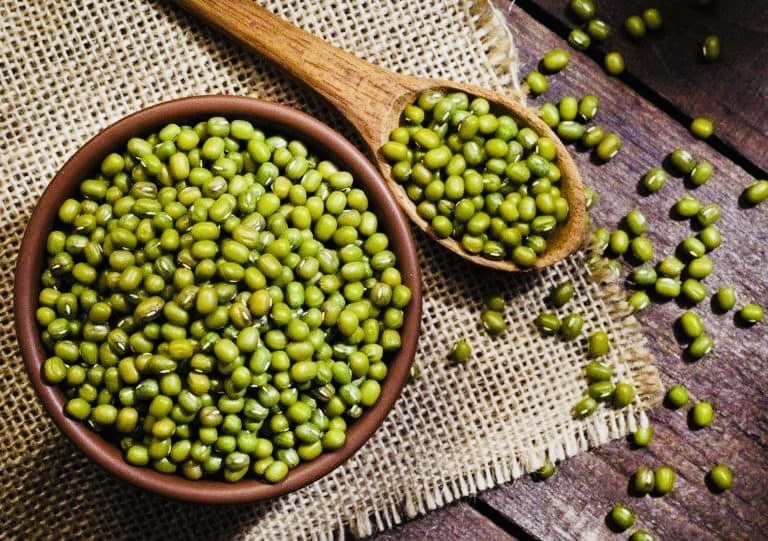Mung beans
The mungbean (Vigna radiata) is also known as the moong bean, green gram and golden gram. Mungbeans are a short season, subtropical plant and are closely related to black gram (Vigna mungo) and azuki beans (Vigna angularis). Mungbeans are native to the Indian subcontinent and mainly grown in India, China and South East Asia.
The mungbean plant is an upright annual legume ranging in height from 45cm to one metre. It branches freely, but is not heavily foliaged. Leaves and stems are slightly hairy and the pods of some varieties may also be hairy. The crop reaches maturity in 90–110 days.
Overview
The first flowers appear seven to eight weeks after planting and are self-pollinating. The pods are borne at the top of the plant are 7.5–10cm long and have between 10 and 15 seeds. Seeds are oval in shape and 100 seeds weigh between 3 and 7g. Seed colour at maturity can range from yellow, greenish-yellow, light green, dull green, black, brown and green mottled with black.
In Australia, the term mungbean refers to the green-seeded types. Mungbeans are classified as a pulse and are commonly used in many Asian dishes, seed appearance and quality are therefore of vital importance. The first commercial mungbean varieties were grown in the 1960s in Australia using varieties introduced from Taiwan. About 95% of the mungbeans produced in Australia are exported.
Marketing of mungbeans is very different to other pulse crops as consumers purchase mungbeans as a vegetable. In this respect production guidelines need to be adhered to and the final grading and processing of the crop is of vital importance.
The mungbean industry in Australia is considered an established industry and its operations are overseen by two industry bodies: the Australian Mungbean Association (AMA) and Pulse Australia.
Facts and figures
• Mungbeans are a member of the pulse grain crops
• As mungbeans are a very short season crop (90–110 days), they are very management intensive
• The soil profiles of paddocks should be assessed for adequate stored water before sowing
• The visual quality of the grain is very important as mungbeans are marketed as vegetables
• Mungbeans are a relatively small summer crop and require specialised marketing
• Over 95% of Australian mungbean production is exported each year
• Helicoverpa and Mirids is a major threat to mungbean production
Production status
India, Burma, Thailand and Indonesia produce almost 90% of the world’s mungbean. Australia’s exports of mungbean have increased with Queensland being the major producer of exported mungbean.
About 90% of the mungbeans produced in Australia are exported to countries such as India, Indonesia, Vietnam, Sri Lanka and Thailand, where they are marketed as a vegetable rather than a bulk grain, so visual quality is very important.
ses
Mungbeans are commonly used in savoury or sweet dishes. They are generally cooked until soft and occasionally used whole in dishes. More commonly the skin is removed and it is used in soups or it is cooked and ground into a paste. As a paste they may be used to make pancakes or ice-cream. The beans may also be sprouted and used in stir fries or spring rolls.
Production Requirements
Growing regions
Mungbeans are produced as spring and summer crops on the Darling Downs and western downs of southern Queensland, as well as central Queensland, and the north west slopes and plains and Liverpool Plains of New South Wales. The total Australian production is generally divided between central Queensland, southern Queensland and northern New South Wales production areas.
In Australia, mungbeans are generally grown under dryland conditions as spring or summer crops, as they do not respond to irrigation as well as other pulses such as soybeans. Paddocks should, therefore, be carefully assessed for appropriate amounts of available water, requiring greater than 100mm of plant available water (PAW) before sowing. Mungbeans are a very quick maturing crop, which fits well in broadacre farming enterprises based on winter cereals or summer crops.
Soil type
Mungbean prefer well drained soils with a medium to heavy texture. They do not tolerate soil compaction or waterlogging. They are not salt tolerant and subsoil acidity can be a problem for mungbeans if pH is less than 5.5 (water).
Mungbean is well suited to no-till situations and planting into standing cereal stubble often encourages them to grow taller, meaning additional height to the lowest pods for ease of harvest. No-till also increases the efficiency of storing moisture in the fallow, reducing the risk of crop failure.
Climate
Mungbeans require a subtropical climate with 90–120 frost free days and at least 8–10 hours of sunlight per day. The optimum temperature range is between 27 and 30°C and they are quite tolerant to heat and drought. They are predominantly grown under dryland conditions in Australia as they generally do not respond well to irrigation.
Varieties
Growers must select the market for which they intend to produce for before selecting the appropriate variety. As the viability of mungbean seed can drop quite rapidly, all mungbean sowing seed should be replaced every two to three years. Seed replacement every three years is also the priory management practice for the control of the seed borne pathogens Tan Spot and Halo blight for which there is no in-crop control options available to growers. Both of these pathogens are seed borne.
Mungbean varieties suitable to Australian growing conditions have been developed through the National Mungbean Breeding Program and many of them are licenced to the Australian Mungbean Association. The most common varieties being produced include Jade AU, Crystal, Satin II, Celera II AU and Regur. Jade AU and Crystal are both large shiny green seeded varieties, Satin II is a large dull seeded one, Celera II AU is small and shiny and Regur is a black seeded type.
Several of the varieties have been commercialized by the Australian Mungbean Association and are protected by Plant Breeders rights. They are available from your local AMA member or seed re-seller. Varietal management packages for Jade-AU, Crystal and Satin II and Celera II are available from the Australian Mungbean Association.
Growers are strongly recommended to secure the services from accredited Australian Mungbean Association agronomists to access appropriate production advice. Further detailed information on mungbean varieties is available from the Australian Mungbean Association.
Planting and crop management
Stored soil moisture needs to be assessed carefully before deciding to sow mungbeans as they are a very short season crop and relying on in-crop rainfall can be risky. Plants should have around 100mm of plant available water (PAW) to produce a profitable crop. If the mungbeans are to be grown under irrigation, advice should be sought from a registered Australian Mungbean Association agronomist.
Paddocks should be selected carefully as herbicide residues can be problematic in mungbeans. They are sensitive to sulfonylurea (Group B), triazine (Group C) and picloram (Group I).
Mungbeans in Australia are either sown in spring (first week of October to second week of November) or summer (last week of December to third week of January). Suitable rainfall events will dictate the exact time of sowing. Spring sowing times are more risky as the crops can suffer from weather damage during harvest and the final grain can be downgraded.
As mungbeans are a legume crop they should be inoculated prior to sowing with the appropriate rhizobium group (Group I) to enable effective fixing of atmospheric nitrogen for the crop to use.
Mungbeans have been successfully sown using a range of planting equipment and at row spacings from 18cm to 1m, with a growing trend to produce mungbeans on wider row spacings. Target plant populations are ideally 20–30 plants/m2. Higher populations may expose crops to lodging especially under irrigation.
Growers are strongly recommended to secure the services from accredited Australian Mungbean Association agronomists to access appropriate production advice. Further details are available on mungbean planting and crop management practices from the New South Wales Department of Primary Industries’ Summer Crop Production Guide 2014 and the Australian Mungbean Association.
Weeds, Pests, And Diseases
Broadleaf weed control in mungbeans is difficult as there are limited control options; growers are encouraged to plan a management strategy with their agronomist prior to planting. Information on herbicides registered by the Australian Pesticide and Veterinary Medicines Authority for use on mungbeans is available from the Australian Mungbean Association.
The most significant diseases that affect mungbeans are powdery mildew and two bacterial diseases: tan spot and halo blight. Growers are able to use appropriately registered sprays to manage powdery mildew and to select varieties with resistance. These two bacterium do not respond to fungicides and growers are encouraged to adopt good hygiene practices and renew their sowing seed every 3–4 years using seed approved by the Australian Mungbean Association.
The major insects that mungbeans are susceptible to are myrids, heliothis and green vegetable bug. As mungbeans are a very short-season crop, they need to be regularly monitored for insect pests, two to three times per week.
Growers are strongly recommended to secure the services of an agronomist accredited by the Australian Mungbean Association, to access appropriate production advice.
Infrastructure Requirements
A successful mungbean enterprise will require large-scale broadacre cropping machinery, including:
• tractors
• cultivation equipment
• seeder/disc drills or row crop planters
• boom sprayers for herbicide and insecticide application
• irrigation equipment and soil moisture monitoring equipment
• combine harvesters (headers)
• chaser bins and grain trucks
• grain silos — if mungbeans are to be stored on farm for any period.
Some or all of the operations required to produce a mungbean crop can be carried out by contractors, which may alleviate some capital investment in the significant amount of equipment required for crop production.
Harvesting & Processing
The visual quality of mungbean seed is a very important aspect of the marketing with bean colour and lustre being paramount. The grains are generally consumed with minimal or no processing so achieving food grade hygiene is critical. Mungbeans demand the highest level of hygiene of all pulses.
Many of the countries that Australia competes with in international mungbean markets produce the beans in traditional ways and harvest their mungbeans by hand. This results in a very high quality product as the beans are individually selected. To be competitive in these markets the Australian industry has developed varieties and management practices that ensure it can produce very high quality products by mechanized means.
The preferred moisture content for the beans for delivery to packing sheds is 12–14%, the maximum level for storage is 12%. As mungbeans are an indeterminate plant, i.e. continuously producing flowers and pods, they may require desiccations prior to harvest to minimize immature grain in the harvest. New growers are recommended to use experienced mungbean contract harvesters to avoid significant grain loss and downgrade in quality.
There are code of practice guidelines for the appropriate grading, storage and transportation of mungbeans in Australia, these are available from the Australian Mungbean Association web site. Grain quality standards are set for the following grades: sprouting, premium, number one, processing and manufacturing, and are available from the Australian Mungbean Association.
All Australian mungbeans are cleaned, gravity graded and bagged through registered processing plants. They may also require fumigation for any live insects and drying to a consistent moisture content. All products must be inspected by Australian Quarantine and Inspection Services (AQIS) to ensure they meet with importing countries requirements and standards. Shipping containers must be of food quality standard and approved by AQIS approved personnel prior to loading.
Markets & Marketing
Around 80% of the Australian mung bean crop is sold into the processing grade market. Less than 5% of the Australian production of mung beans goes into the sprouting market. Growers generally sell to Australian based grading and processing businesses or grain brokers. A list of accredited processors can be found on the Australian Mung bean Association website.
The processing grade is a broad classification of mung bean quality. Within this classification prices can vary by as much as $150 per tonne depending on the appearance and quality. Growers should consult the Australian Mungbean Association for the latest prices and marketing information.
Over 90% of Australian mungbeans are exported to countries such as India, Indonesia, Vietnam, Sri Lanka and Thailand, for various uses.
Buyers of mungbeans assess the visual appearance of the beans and look for bright green even color, varietal purity and good size. Prices are usually based on final graded product rather than ‘farmer dressed’ i.e. direct off header. Mungbeans are classified into three main grades:
• number 1
• processing
• manufacturing.
An industry wide quality assurance scheme is run in Australia for mungbeans and a commodity vendor statement, available from the Australian Mungbean Association, is required by packing sheds to maintain high levels of hygiene and food safety. Export standards are very stringent and all processing plants are required to be registered and maintain AQIS standards which focus on a high level of hygiene.
Risks & Regulations
Risks/challenges
As with all agricultural pursuits, risk is inherent in growing mung beans and can include:
• the crop failing to establish or mature properly due to adverse weather events, thus resulting in reduced harvest tonnage and/or poor quality product
• commodity prices failing during the growth period impacting on the returns projected at planting
• not recouping the costs of inputs and capital invested in the crop, like fertilizer or the cost of running large equipment if the crop fails.
As mung beans are a very short season crop, they are management intensive as there is little time for the crops to compensate if they suffer any set back from insect or disease attack or lack of water. They must be sown into an adequate amount of stored soil moisture.
Regulatory considerations
Apart from the regulatory considerations that apply to all Australian grain farms, including laws applying to chemical use and management, occupational health and safety and transport (including machinery movements and the loading/unloading of harvested grain), there are no additional regulations that are specific to mungbean operations.




